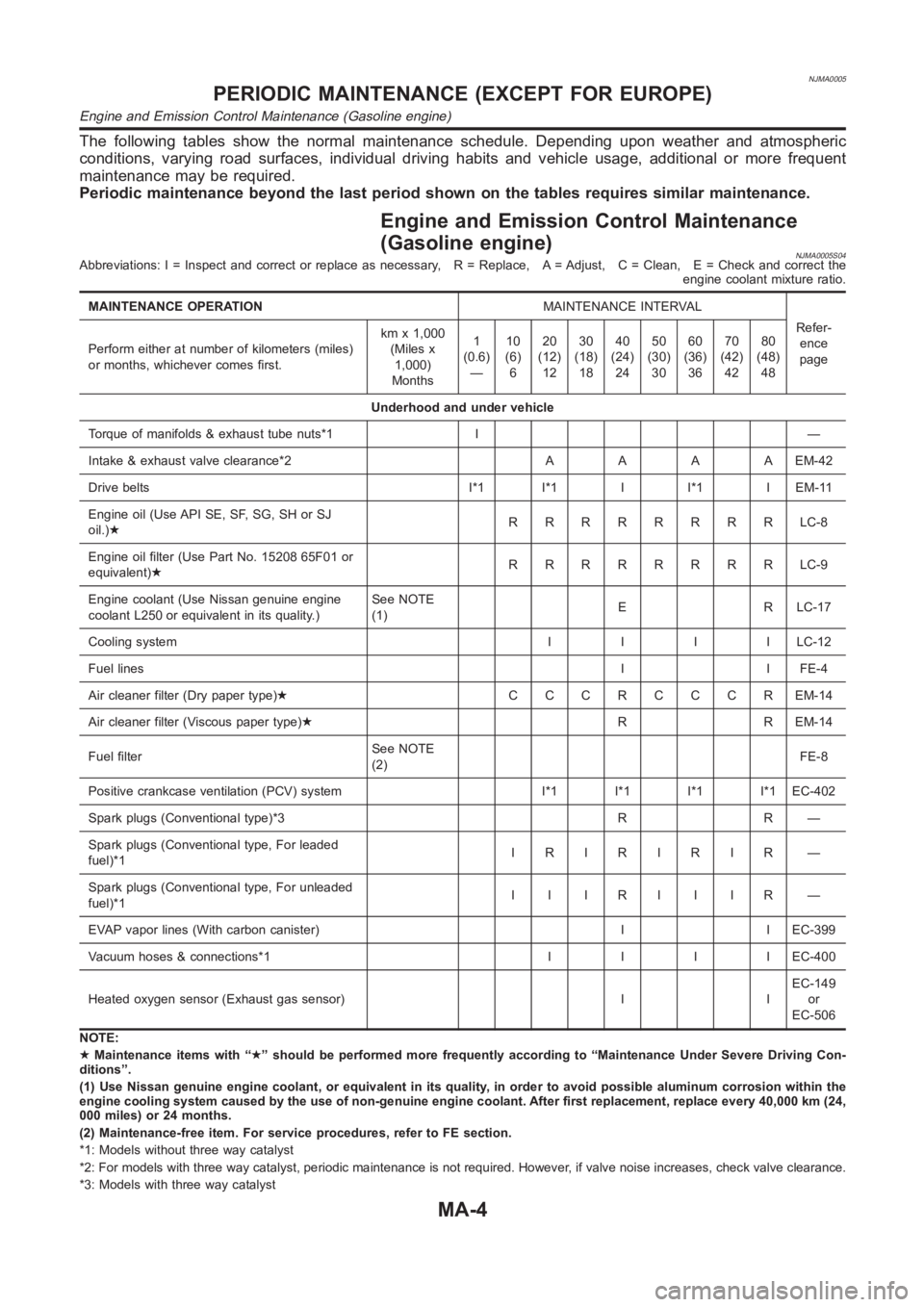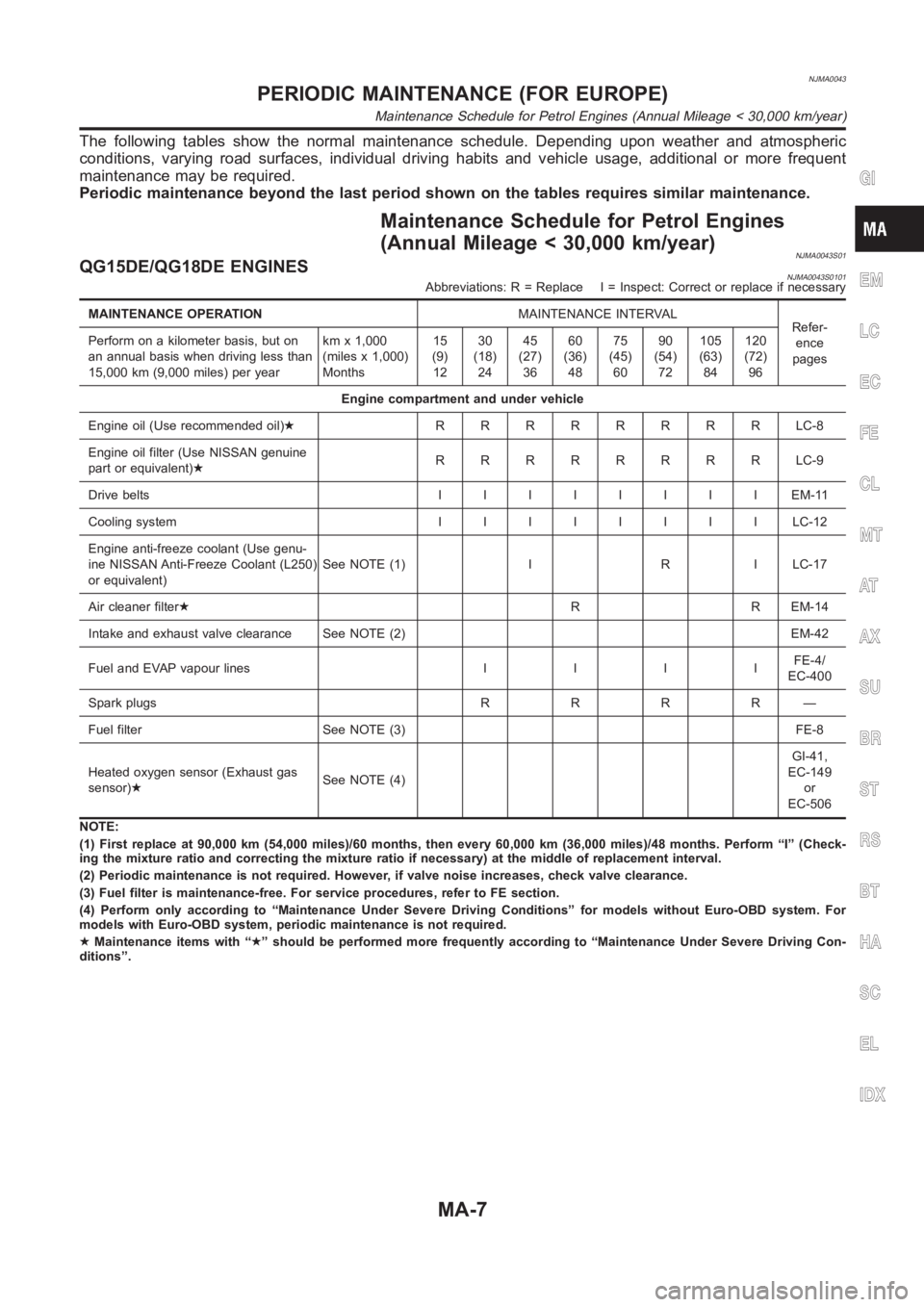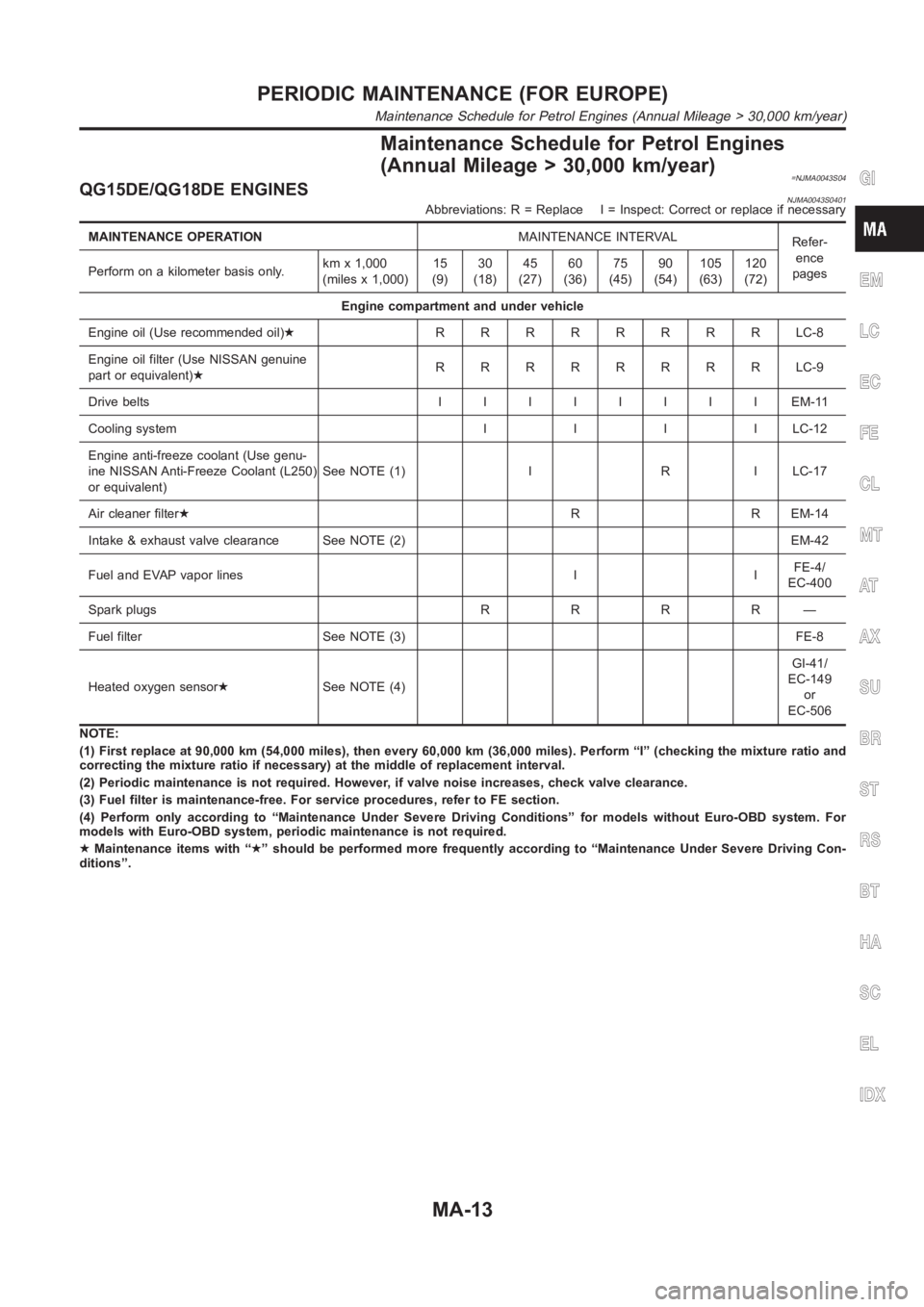2003 NISSAN ALMERA N16 spark plugs
[x] Cancel search: spark plugsPage 60 of 3189

NJMA0005
The following tables show the normal maintenance schedule. Depending upon weather and atmospheric
conditions, varying road surfaces, individual driving habits and vehicle usage, additional or more frequent
maintenance may be required.
Periodic maintenance beyond the last period shown on the tables requires similar maintenance.
Engine and Emission Control Maintenance
(Gasoline engine)
NJMA0005S04Abbreviations: I = Inspect and correct or replace as necessary, R = Replace, A = Adjust, C = Clean, E = Check and correct the
engine coolant mixture ratio.
MAINTENANCE OPERATIONMAINTENANCE INTERVAL
Refer-
ence
page Perform either at number of kilometers (miles)
or months, whichever comes first.kmx1,000
(Miles x
1,000)
Months1
(0.6)
—10
(6)
620
(12)
1230
(18)
1840
(24)
2450
(30)
3060
(36)
3670
(42)
4280
(48)
48
Underhood and under vehicle
Torque of manifolds & exhaust tube nuts*1 I —
Intake & exhaust valve clearance*2AAAAEM-42
Drive belts I*1 I*1 I I*1 I EM-11
Engine oil (Use API SE, SF, SG, SH or SJ
oil.)★RRRRRRRRLC-8
Engine oil filter (Use Part No. 15208 65F01 or
equivalent)★RRRRRRRRLC-9
Engine coolant (Use Nissan genuine engine
coolant L250 or equivalent in its quality.)See NOTE
(1)E R LC-17
Cooling systemIIIILC-12
Fuel linesI I FE-4
Air cleaner filter (Dry paper type)★CCCRCCCREM-14
Air cleaner filter (Viscous paper type)★R R EM-14
Fuel filterSee NOTE
(2)FE-8
Positive crankcase ventilation (PCV) system I*1 I*1 I*1 I*1 EC-402
Spark plugs (Conventional type)*3 R R —
Spark plugs (Conventional type, For leaded
fuel)*1IRIRIRIR —
Spark plugs (Conventional type, For unleaded
fuel)*1IIIRIIIR —
EVAP vapor lines (With carbon canister) I I EC-399
Vacuum hoses & connections*1IIIIEC-400
Heated oxygen sensor (Exhaust gas sensor) I IEC-149
or
EC-506
NOTE:
★Maintenance items with “★” should be performed more frequently according to “Maintenance Under Severe Driving Con-
ditions”.
(1) Use Nissan genuine engine coolant, or equivalent in its quality, in order to avoid possible aluminum corrosion within the
engine cooling system caused by the use of non-genuine engine coolant. After first replacement, replace every 40,000 km (24,
000 miles) or 24 months.
(2) Maintenance-free item. For service procedures, refer to FE section.
*1: Models without three way catalyst
*2: For models with three way catalyst, periodic maintenance is not requir
ed. However, if valve noise increases, check valve clearance.
*3: Models with three way catalyst
PERIODIC MAINTENANCE (EXCEPT FOR EUROPE)
Engine and Emission Control Maintenance (Gasoline engine)
MA-4
Page 63 of 3189

NJMA0043
The following tables show the normal maintenance schedule. Depending upon weather and atmospheric
conditions, varying road surfaces, individual driving habits and vehicle usage, additional or more frequent
maintenance may be required.
Periodic maintenance beyond the last period shown on the tables requires similar maintenance.
Maintenance Schedule for Petrol Engines
(Annual Mileage < 30,000 km/year)
NJMA0043S01QG15DE/QG18DE ENGINESNJMA0043S0101Abbreviations: R = Replace I = Inspect: Correct or replace if necessary
MAINTENANCE OPERATIONMAINTENANCE INTERVAL
Refer-
ence
pages Perform on a kilometer basis, but on
an annual basis when driving less than
15,000 km (9,000 miles) per yearkmx1,000
(miles x 1,000)
Months15
(9)
1230
(18)
2445
(27)
3660
(36)
4875
(45)
6090
(54)
72105
(63)
84120
(72)
96
Engine compartment and under vehicle
Engine oil (Use recommended oil)★RRRRRRRRLC-8
Engine oil filter (Use NISSAN genuine
part or equivalent)★RRRRRRRRLC-9
Drive beltsIIIIIIIIEM-11
Cooling systemIIIIIIIILC-12
Engine anti-freeze coolant (Use genu-
ine NISSAN Anti-Freeze Coolant (L250)
or equivalent)See NOTE (1) I R I LC-17
Air cleaner filter★R R EM-14
Intake and exhaust valve clearance See NOTE (2) EM-42
Fuel and EVAP vapour linesIIIIFE-4/
EC-400
Spark plugsRRRR—
Fuel filter See NOTE (3) FE-8
Heated oxygen sensor (Exhaust gas
sensor)★See NOTE (4)GI-41,
EC-149
or
EC-506
NOTE:
(1) First replace at 90,000 km (54,000 miles)/60 months, then every 60,000km (36,000 miles)/48 months. Perform “I” (Check-
ing the mixture ratio and correcting the mixture ratio if necessary) at themiddle of replacement interval.
(2) Periodic maintenance is not required. However, if valve noise increases, check valve clearance.
(3) Fuel filter is maintenance-free. For service procedures, refer to FE section.
(4) Perform only according to “Maintenance Under Severe Driving Conditions” for models without Euro-OBD system. For
models with Euro-OBD system, periodic maintenance is not required.
★Maintenance items with “★” should be performed more frequently according to “Maintenance Under Severe Driving Con-
ditions”.
GI
EM
LC
EC
FE
CL
MT
AT
AX
SU
BR
ST
RS
BT
HA
SC
EL
IDX
PERIODIC MAINTENANCE (FOR EUROPE)
Maintenance Schedule for Petrol Engines (Annual Mileage < 30,000 km/year)
MA-7
Page 69 of 3189

Maintenance Schedule for Petrol Engines
(Annual Mileage > 30,000 km/year)
=NJMA0043S04QG15DE/QG18DE ENGINESNJMA0043S0401Abbreviations: R = Replace I = Inspect: Correct or replace if necessary
MAINTENANCE OPERATIONMAINTENANCE INTERVAL
Refer-
ence
pages Perform on a kilometer basis only.kmx1,000
(miles x 1,000)15
(9)30
(18)45
(27)60
(36)75
(45)90
(54)105
(63)120
(72)
Engine compartment and under vehicle
Engine oil (Use recommended oil)★RRRRRRRRLC-8
Engine oil filter (Use NISSAN genuine
part or equivalent)★RRRRRRRRLC-9
Drive beltsIIIIIIIIEM-11
Cooling systemIIIILC-12
Engine anti-freeze coolant (Use genu-
ine NISSAN Anti-Freeze Coolant (L250)
or equivalent)See NOTE (1) I R I LC-17
Air cleaner filter★R R EM-14
Intake & exhaust valve clearance See NOTE (2) EM-42
Fuel and EVAP vapor lines I IFE-4/
EC-400
Spark plugsRRRR—
Fuel filter See NOTE (3) FE-8
Heated oxygen sensor★See NOTE (4)GI-41/
EC-149
or
EC-506
NOTE:
(1) First replace at 90,000 km (54,000 miles), then every 60,000 km (36,000miles). Perform “I” (checking the mixture ratio and
correcting the mixture ratio if necessary) at the middle of replacement interval.
(2) Periodic maintenance is not required. However, if valve noise increases, check valve clearance.
(3) Fuel filter is maintenance-free. For service procedures, refer to FE section.
(4) Perform only according to “Maintenance Under Severe Driving Conditions” for models without Euro-OBD system. For
models with Euro-OBD system, periodic maintenance is not required.
★Maintenance items with “★” should be performed more frequently according to “Maintenance Under Severe Driving Con-
ditions”.
GI
EM
LC
EC
FE
CL
MT
AT
AX
SU
BR
ST
RS
BT
HA
SC
EL
IDX
PERIODIC MAINTENANCE (FOR EUROPE)
Maintenance Schedule for Petrol Engines (Annual Mileage > 30,000 km/year)
MA-13
Page 103 of 3189
![NISSAN ALMERA N16 2003 Electronic Repair Manual SPARK PLUG (CONVENTIONAL)
EM-25
[QG]
C
D
E
F
G
H
I
J
K
L
MA
EM
SPARK PLUG (CONVENTIONAL)PFP:22401
Removal and InstallationEBS00LQ8
REMOVAL
1. Disconnect ignition coil harness connector from ignition c NISSAN ALMERA N16 2003 Electronic Repair Manual SPARK PLUG (CONVENTIONAL)
EM-25
[QG]
C
D
E
F
G
H
I
J
K
L
MA
EM
SPARK PLUG (CONVENTIONAL)PFP:22401
Removal and InstallationEBS00LQ8
REMOVAL
1. Disconnect ignition coil harness connector from ignition c](/manual-img/5/57350/w960_57350-102.png)
SPARK PLUG (CONVENTIONAL)
EM-25
[QG]
C
D
E
F
G
H
I
J
K
L
MA
EM
SPARK PLUG (CONVENTIONAL)PFP:22401
Removal and InstallationEBS00LQ8
REMOVAL
1. Disconnect ignition coil harness connector from ignition coil.
2. Remove ignition coil.
3. Remove spark plugs with a spark plug wrench (commercial ser-
vice tool).
Spark plug
INSPECTION AFTER REMOVAL
Check spark plug gap. Adjust or replace if necessary.
●Use a wire brush for cleaning, if necessary.
INSTALLATION
Install in the reverse order of removal, paying attention to the following.
Make NGK Champion
Standard type LFR5A-11 REC10YC4
Hot type LFR4A-11 —
Cold type LFR6A-11 —
SMA581C
Standard : 1.0 - 1.1 mm (0.039 - 0.043 in)
SMA476
Spark plug:
: 19.6 - 29.4 N·m (2.0 - 3.0 kg-m, 15 - 21 ft-lb)
Page 388 of 3189
![NISSAN ALMERA N16 2003 Electronic Repair Manual EC-58
[QG (WITH EURO-OBD)]
TROUBLE DIAGNOSIS
TROUBLE DIAGNOSIS
PFP:00004
Trouble Diagnosis IntroductionEBS00K3L
INTRODUCTION
The engine has an ECM to control major systems such as fuel con-
trol, ign NISSAN ALMERA N16 2003 Electronic Repair Manual EC-58
[QG (WITH EURO-OBD)]
TROUBLE DIAGNOSIS
TROUBLE DIAGNOSIS
PFP:00004
Trouble Diagnosis IntroductionEBS00K3L
INTRODUCTION
The engine has an ECM to control major systems such as fuel con-
trol, ign](/manual-img/5/57350/w960_57350-387.png)
EC-58
[QG (WITH EURO-OBD)]
TROUBLE DIAGNOSIS
TROUBLE DIAGNOSIS
PFP:00004
Trouble Diagnosis IntroductionEBS00K3L
INTRODUCTION
The engine has an ECM to control major systems such as fuel con-
trol, ignition control, idle air control system, etc. The ECM accepts
input signals from sensors and instantly drives actuators. It is essen-
tial that both input and output signals are proper and stable. At the
same time, it is important that there are no malfunctions such as vac-
uum leaks, fouled spark plugs, or other malfunctions with the engine.
It is much more difficult to diagnose a incident that occurs intermit-
tently rather than continuously. Most intermittent incidents are
caused by poor electric connections or improper wiring. In this case,
careful checking of suspected circuits may help prevent the replace-
ment of good parts.
A visual check only may not find the cause of the incidents. A road
test with CONSULT-II (or GST) or a circuit tester connected should
be performed. Follow the “Work Flow” on EC-59
.
Before undertaking actual checks, take a few minutes to talk with a
customer who approaches with a driveability complaint. The cus-
tomer can supply good information about such incidents, especially
intermittent ones. Find out what symptoms are present and under
what conditions they occur. A “Diagnostic Worksheet” like the exam-
ple on EC-62
should be used.
Start your diagnosis by looking for “conventional” malfunctions first.
This will help troubleshoot driveability malfunctions on an electroni-
cally controlled engine vehicle.
MEF036D
SEF233G
SEF234G
Page 425 of 3189
![NISSAN ALMERA N16 2003 Electronic Repair Manual TROUBLE DIAGNOSIS
EC-95
[QG (WITH EURO-OBD)]
C
D
E
F
G
H
I
J
K
L
MA
EC
ACTIVE TEST MODE
Test Item
*: Leaving cooling fan ″OFF″ with CONSULT-II while engine is running may cause the engine to overh NISSAN ALMERA N16 2003 Electronic Repair Manual TROUBLE DIAGNOSIS
EC-95
[QG (WITH EURO-OBD)]
C
D
E
F
G
H
I
J
K
L
MA
EC
ACTIVE TEST MODE
Test Item
*: Leaving cooling fan ″OFF″ with CONSULT-II while engine is running may cause the engine to overh](/manual-img/5/57350/w960_57350-424.png)
TROUBLE DIAGNOSIS
EC-95
[QG (WITH EURO-OBD)]
C
D
E
F
G
H
I
J
K
L
MA
EC
ACTIVE TEST MODE
Test Item
*: Leaving cooling fan ″OFF″ with CONSULT-II while engine is running may cause the engine to overheat.
DTC & SRT CONFIRMATION MODE
SRT STATUS Mode
For details, refer to EC-40, "SYSTEM READINESS TEST (SRT) CODE" .
SRT Work Support Mode
This mode enables a technician to drive a vehicle to set the SRT while monitoring the SRT status.
TEST ITEM CONDITION JUDGEMENT CHECK ITEM (REMEDY)
FUEL INJEC-
TION
●Engine: Return to the original
trouble condition
●Change the amount of fuel injec-
tion using CONSULT-II.If trouble symptom disappears, see
CHECK ITEM.
●Harness and connectors
●Fuel injectors
●Heated oxygen sensor 1
IGNITION TIM-
ING
●Engine: Return to the original
trouble condition
●Timing light: Set
●Retard the ignition timing using
CONSULT-II.If trouble symptom disappears, see
CHECK ITEM.
●Perform “Idle Air Volume Learn-
ing”.
POWER BAL-
ANCE
●Engine: After warming up, idle
the engine.
●A/C switch “OFF”
●Shift lever:
N (A/T models)
Neutral (M/T models)
●Cut off each injector signal one at
a time using CONSULT-II.Engine runs rough or dies.
●Harness and connectors
●Compression
●Fuel injectors
●Power transistor
●Spark plugs
●Ignition coils
COOLING FAN*
●Ignition switch: ON
●Turn the cooling fan “ON” and
“OFF” with CONSULT-II.Cooling fan moves and stops.
●Harness and connectors
●Cooling fan relay
●Cooling fan motor
ENG COOLANT
TEMP
●Engine: Return to the original
trouble condition
●Change the engine coolant tem-
perature using CONSULT-II.If trouble symptom disappears, see
CHECK ITEM.
●Harness and connectors
●Engine coolant temperature sen-
sor
●Fuel injectors
FUEL PUMP
RELAY
●Ignition switch: ON (Engine
stopped)
●Turn the fuel pump relay “ON”
and “OFF” using CONSULT-II
and listen to operating sound.Fuel pump relay makes the operat-
ing sound.●Harness and connectors
●Fuel pump relay
PURG VOL
CONT/V
●Engine: After warming up, run
engine at 1,500 rpm.
●Change the EVAP canister purge
volume control solenoid valve
opening percent using CON-
SULT-II.Engine speed changes according to
the opening percent.●Harness and connectors
●Solenoid valve
V/T ASSIGN
ANGLE
●Engine: Return to the original
trouble condition
●Change intake valve timing using
CONSULT-II.If trouble symptom disappears, see
CHECK ITEM.
●Harness and connectors
●Intake valve timing control sole-
noid valve
Page 558 of 3189
![NISSAN ALMERA N16 2003 Electronic Repair Manual EC-228
[QG (WITH EURO-OBD)]
DTC P0300 - P0304 MULTIPLE CYLINDER MISFIRE, NO. 1 - 4 CYLINDER MIS-
FIRE
6. CHECK SPARK PLUGS
Remove the spark plugs and check for fouling, etc.
OK or NG
OK >> GO TO 7.
NG NISSAN ALMERA N16 2003 Electronic Repair Manual EC-228
[QG (WITH EURO-OBD)]
DTC P0300 - P0304 MULTIPLE CYLINDER MISFIRE, NO. 1 - 4 CYLINDER MIS-
FIRE
6. CHECK SPARK PLUGS
Remove the spark plugs and check for fouling, etc.
OK or NG
OK >> GO TO 7.
NG](/manual-img/5/57350/w960_57350-557.png)
EC-228
[QG (WITH EURO-OBD)]
DTC P0300 - P0304 MULTIPLE CYLINDER MISFIRE, NO. 1 - 4 CYLINDER MIS-
FIRE
6. CHECK SPARK PLUGS
Remove the spark plugs and check for fouling, etc.
OK or NG
OK >> GO TO 7.
NG >> Repair or replace spark plug(s) with standard type
one(s). For spark plug type, refer to MA-7.
7. CHECK COMPRESSION PRESSURE
Check compression pressure. Refer to EM-57, "
CHECKING COMPRESSION PRESSURE" .
QG15DE engine
QG18DE engine
OK or NG
OK >> GO TO 8.
NG >> Check pistons, piston rings, valves, valve seats and cylinder head gaskets.
8. CHECK FUEL PRESSURE
1. Install all removed parts.
2. Release fuel pressure to zero. Refer to EC-34, "
FUEL PRESSURE RELEASE" .
3. Install fuel pressure gauge and check fuel pressure. Refer to EC-34, "
FUEL PRESSURE CHECK" .
OK or NG
OK >> GO TO 9.
NG >> Follow the construction of “FUEL PRESSURE CHECK”.
SEF156I
Standard:
1,372 kPa (13.720 bar, 13.99 kg/cm2 , 198.9 psi)/350 rpm
Minimum:
1,176 kPa (11.759 bar, 11.99 kg/cm
2 , 170.5 psi)/350 rpm
Difference between each
cylinder:98 kPa (0.98 bar, 1.0 kg/cm
2 , 14 psi)/350 rpm
Standard:
1,324 kPa (13.24 bar, 13.5 kg/cm
2 , 192 psi)/350 rpm
Minimum:
1,128 kPa (11.28 bar, 11.5 kg/cm
2 , 164 psi)/350 rpm
Difference between each
cylinder:98 kPa (0.98 bar, 1.0 kg/cm
2 , 14 psi)/350 rpm
At idle: Approx. 350 kPa (3.5 bar, 3.57 kg/cm
2 , 51 psi)
Page 766 of 3189
![NISSAN ALMERA N16 2003 Electronic Repair Manual EC-436
[QG (WITHOUT EURO-OBD)]
TROUBLE DIAGNOSIS
TROUBLE DIAGNOSIS
PFP:00004
Trouble Diagnosis IntroductionEBS00KER
INTRODUCTION
The engine has an ECM to control major systems such as fuel con-
trol, NISSAN ALMERA N16 2003 Electronic Repair Manual EC-436
[QG (WITHOUT EURO-OBD)]
TROUBLE DIAGNOSIS
TROUBLE DIAGNOSIS
PFP:00004
Trouble Diagnosis IntroductionEBS00KER
INTRODUCTION
The engine has an ECM to control major systems such as fuel con-
trol,](/manual-img/5/57350/w960_57350-765.png)
EC-436
[QG (WITHOUT EURO-OBD)]
TROUBLE DIAGNOSIS
TROUBLE DIAGNOSIS
PFP:00004
Trouble Diagnosis IntroductionEBS00KER
INTRODUCTION
The engine has an ECM to control major systems such as fuel con-
trol, ignition control, idle air control system, etc. The ECM accepts
input signals from sensors and instantly drives actuators. It is essen-
tial that both input and output signals are proper and stable. At the
same time, it is important that there are no malfunctions such as vac-
uum leaks, fouled spark plugs, or other malfunctions with the engine.
It is much more difficult to diagnose a incident that occurs intermit-
tently rather than continuously. Most intermittent incidents are
caused by poor electric connections or improper wiring. In this case,
careful checking of suspected circuits may help prevent the replace-
ment of good parts.
A visual check only may not find the cause of the incidents. A road
test with CONSULT-II or a circuit tester connected should be per-
formed. Follow the “Work Flow” on EC-437
.
Before undertaking actual checks, take a few minutes to talk with a
customer who approaches with a driveability complaint. The cus-
tomer can supply good information about such incidents, especially
intermittent ones. Find out what symptoms are present and under
what conditions they occur. A “Diagnostic Worksheet” like the exam-
ple on EC-440
should be used.
Start your diagnosis by looking for “conventional” malfunctions first.
This will help troubleshoot driveability malfunctions on an electroni-
cally controlled engine vehicle.
MEF036D
SEF233G
SEF234G